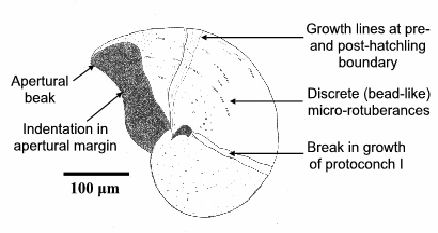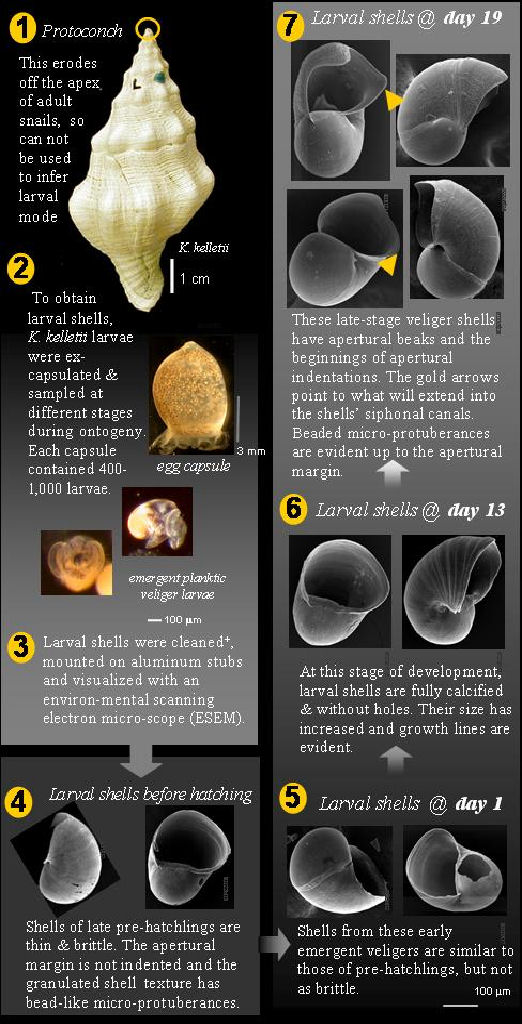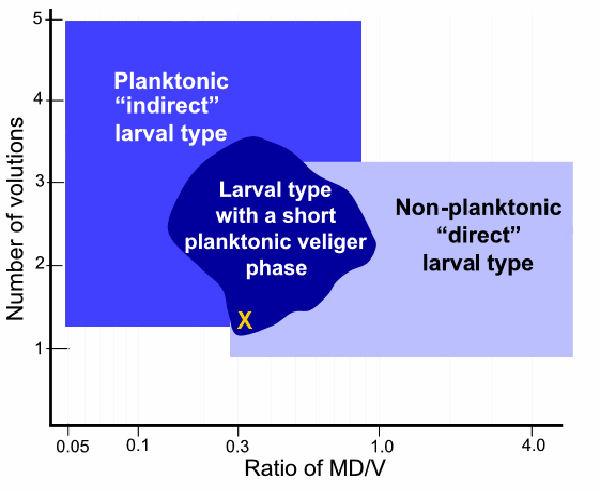

Jann Elizabeth Vendetti,
UC Berkeley, Dept. of Integrative Biology & Museum of Paleontology, 1101 VLSB, Berkeley, CA 94720-4780, jan...@berkeley.edu
Morphological characters of the gastropod larval shell (protoconch) have
been used widely by malacologists and paleontologists to infer snails'
developmental mode as either planktotrophic (planktonic) or lecithotrophic
(non-planktonic). Because size and shape characters are the criteria of
inference, the larval shells of extant as well as extinct taxa can be
examined. In this study I characterized the larval biology and larval
shell characters of an extant buccinid gastropod (Kelletia kelletii
Forbes) with planktonic veligers. These data were used to test predictions
of larval developmental mode based on protoconch morphology. Larval shell
size, shape, and microstructure were identified from scanning electron
microscope (SEM) images, then compared to the "apex theory"
parameters and criteria described in Thorson (1950), Shuto (1974), and
Hanson (1980-1982). This study concluded that larval shell shape data
were sufficient to correctly infer larval developmental mode in Kelletia
kelletii. Additional studies will further test the accuracy of morphology-based
predictions of developmental mode in buccinids with non-planktonic development.
Introduction and Background
Kelletia kelletii is a marine, subtidal East Pacific gastropod
with a "mixed" developmental mode (Buckland-Nicks et al.,
2002). Its ontogeny begins within a benthic egg capsule, like all the
Buccinidae, but instead of wholly intracapsular development, K. kelletii
larvae emerge from their capsules as planktonic veligers and continue
to grow in the plankton until metamorphosis (Rosenthal, 1970). Many
caenogastropods share this larval strategy, which is referred to as
pelagic, planktonic, or planktotrophic depending on definition subtleties
and the perspective of the author. Intracapsular development, in which
larvae emerge from egg capsules as crawl-away juveniles, is called non-pelagic,
non-planktonic, lecithotrophic, or "direct" (Jablonski and
Lutz, 1983).
Proposed Research
This research project posed the following questions;
(1) What are the protoconch/larval shell characters of Kelletia kelletii?
(2) Are the widely employed criteria for inferring larval mode from
protoconch/larval shell parameters suitable for it as a buccinid species
with mixed development?
(3) What implications do these conclusions have for the inference of
developmental mode from fossil buccinids?
To answer these questions, I chronicled the early ontogeny of K.
kelletii reared in the laboratory (Figure 1 & 2) and analyzed
the larval shell size and shape of their veligers by the "apex
theory" parameters described in Thorson (1950), Shuto (1974), and
Hanson (1980-1982).
 |
Figure 1. Kelletia kelletii larval shell |
| Research to date Twelve Kelletia kelletii individuals were collected from subtidal kelp forests near Santa Barbara and Monterey, California. Specimens were housed in a re-circulating aquarium at UC Berkeley and their mating and oviposition behaviors were recorded until August, 2006. Embryos and larvae were excapsulated at different stages of development for observation and sampling. Particular attention was paid to the morphology of veligers and the properties of their shells. Several ontogenetic series of larval shells were prepared from 35 samples of intracapsular veligers and emerged veligers. Isolated larval shells were prepared for SEM analysis following protocol from Pedersen & Page (2000) and visualized using an environmental SEM (Philips XL-30). To test "apex theory" predictions of K. kelletii based on protoconch parameters, the ratio of maximum diameter to number of volutions or whorls (Shuto, 1974 and Hanson,1980-1982) was calculated from twenty larval shells images in apical orientation with little to no distortion. Measurements were made from digital SEM images directly, using the analyzing software, ImageJ®. |
Fig. 2. Kelletia
kelletii through ontogeny; from adult to planktonic veliger.
 |
||||||||||||
| Conclusions and Significance The larval shell characters of K. kelletii are shared by gastropods of both planktonic and non- planktonic developmental modes (Table 1); an observation that reveals this species' mixed developmental strategy. Its larval shape parameters also accurately correspond to Shuto's (1974) category of prosobranch gastropods with a short planktotrophic (planktonic) stage (Fig. 3). Therefore, shape and size parameters as outlined in the literature are effective in inferring larval developmental mode in this extant buccinid. Additional comparative tests of this kind with direct-developing buccinids should be done to compliment this study and further test the predictive power of protoconch morphology metrics in extinct buccinids and caenogastropods. |
|||||||||||||
| Table 1. Generalized morphological traits of gastropod larval shell characters by developmental mode. Characters of K. kelletii are in bold. |
|
||||||||||||
| Fig. 3. Relation of whorl number to MD/V, a ratio determined to be one of several lines of evidence from which to infer a gastropod's development mode. The X indicates K. kelletii. Based on Shuto (1974). |  |
Future directions
In the near future, I will analyze the larval shells of a related buccinid,
Lirabuccinum dirum Reeve (Amano and Vermeij, 2003), which has
a "direct developing" oviparous larval strategy. Oviposition
in this species peaks between December and February in Northern California
and I have been granted permission to collect and study specimens at
the University of California marine laboratory and field station in
Bodega, California. I will characterize the early ontogeny of L.dirum
using the same methods described above with K.kelletii.
I will also characterize the protoconch morphology of an extinct suite
of buccinid species within the genus Bruclarkia, which have been
collected from the Pacific Northwest and California and housed at the
University of California Museum of Paleontology. Specimens are in various
stages of preservation and many protoconchs are in the form of steinkerns,
which will be cast to examine their microstructure, shape parameters,
and characters. This array of studies will elucidate the larval developmental
modes of the Buccinidae now and through the Cenozoic, giving a clearer
picture of the evolution and polarity of larval mode, its plasticity,
and its implications, including dispersal, endemism, and speciation.
Acknowledgement
I extend my most sincere appreciation to the Malacological Society of
London for the generous funds of the Centenary Research Grant. Without
them this project would not have been possible.
Literature Cited
| Amano K., & G. J. Vermeij. 2003. Evolutionary adaptation and geographic spread of the Cenozoic | |
| buccinid genus Lirabuccinum in the NorthPacific. Journal of Paleontology 77(5): 863-872. | |
| Buckland-Nicks, J. Gibson, G. & R. Koss. 2002. Phylum Mollusca: Gastropoda. In (Ed.) Young, C.M. | |
| Atlas of Marine Invertebrate Larvae Academic Press, New York, 640 pp. | |
| Hansen, T.A. 1980. Influence of larval dispersal and geographic distribution on species | |
| longevity in neogastropods. Paleobiology 6(2): 193-207. | |
| Hansen, T.A. 1982. Modes of larval development in Early Tertiary neogastropods. | |
| Paleobiology 8(4): 367-377. | |
| ImageJ®, Image Processing and Analysis in Java. 2004. (public domain) National Institutes of | |
| Health, http://rsb.info.nih.gov/ij/ | |
| Jablonski, D. & R.A. Lutz. 1983. Larval ecology of marine benthic invertebrates: paleobiological | |
| implications. Biol. Rev. 58: 21-89. | |
| Pederson, R.V.K. & L.R. Page, 2000. Development and metamorphosis of the planktotrophic larvae | |
| of the moon snail, Polinices lewisii(Gould, 1847) (Caenogastropoda: Naticoidea). The Veliger 43: 58-63. | |
| Rosenthal, R.J. 1970. Observations on the reproductive biology of the Kellet's whelk, Kelletia kelletii. | |
| The Veliger 12(3): 319-324. | |
| Shuto, T. 1974. Larval ecology of prosobranch gastropods and its bearing on biogeography and | |
| paleontology. Lethaia 7: 239-256. | |
| Thorson, G. 1950. Reproductive and larval ecology of marine bottom invertebrates. Biol. Rev. | |
| 25: 1-45. | |
Table 1. Generalized morphological traits of gastropod larval shell characters
by developmental mode. Characters of K. kelletii are in bold.
Planktonic "indirect" Non-planktonic "direct"
1.5-9 whorls (multispiral) 0.5-1.5 whorls (paucispiral)
High conical spiral Bulbous apex
Sinusigera No sinusigera
Reticulate or cancellate ormanentation, ribs Simple or no ornamentation
Protoconch I/II boundary marked No protoconch I/II boundary